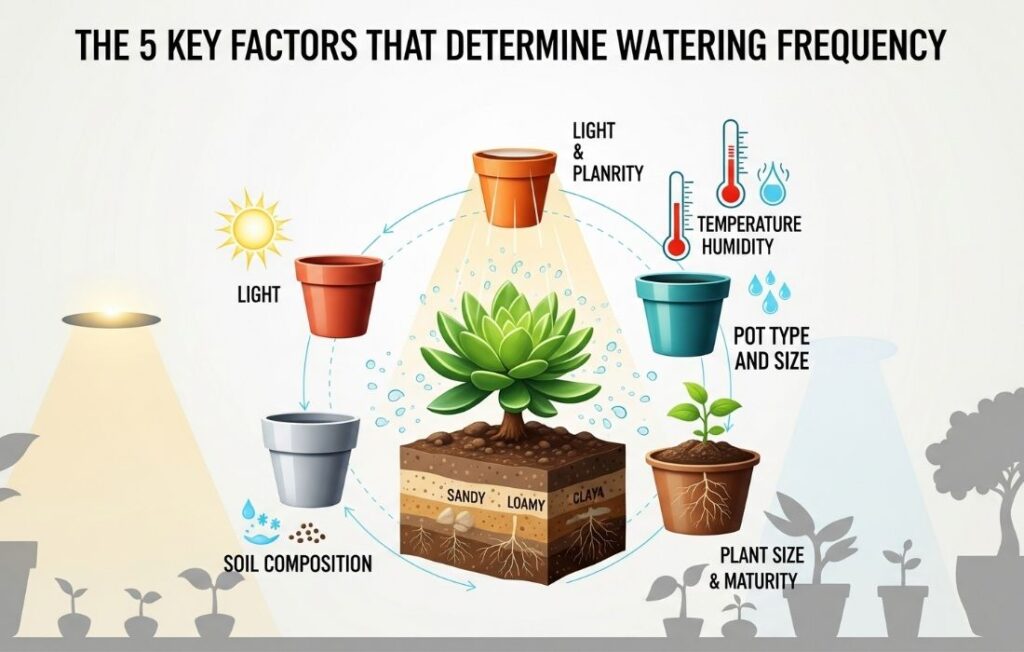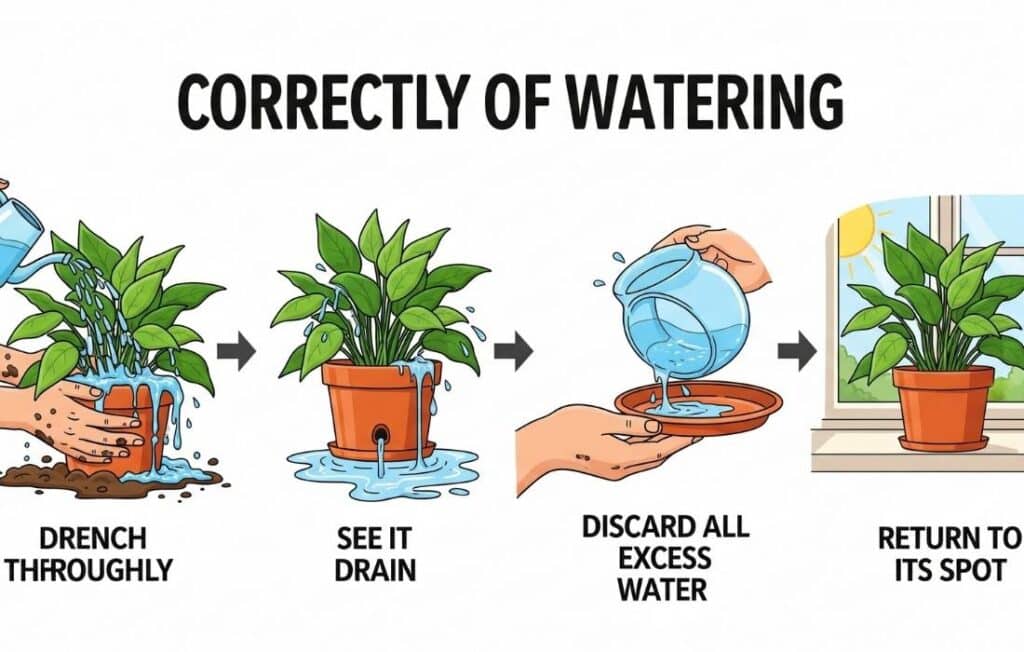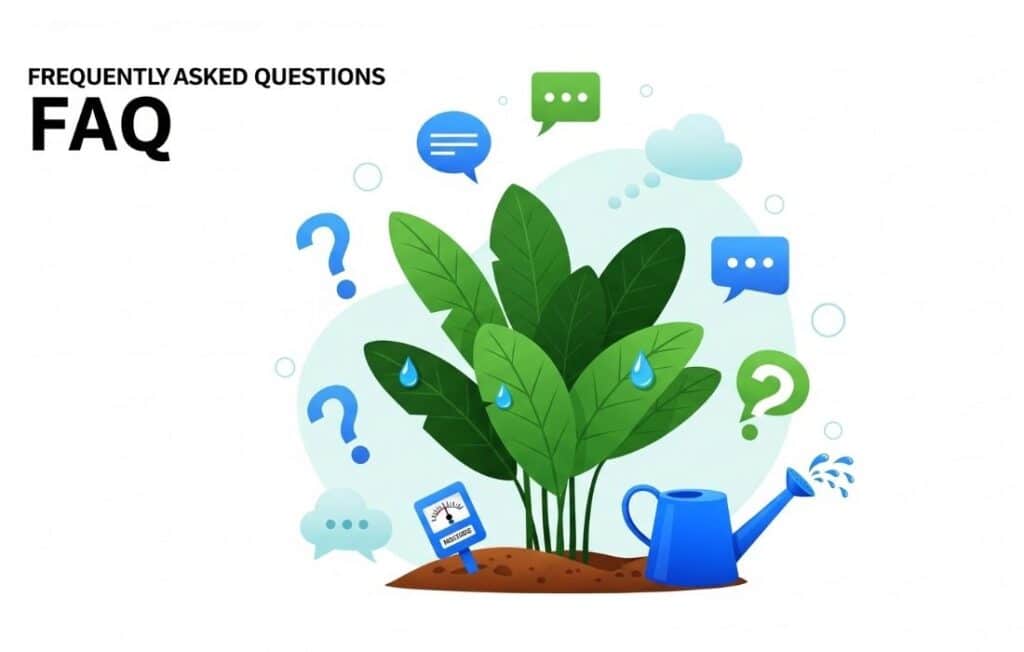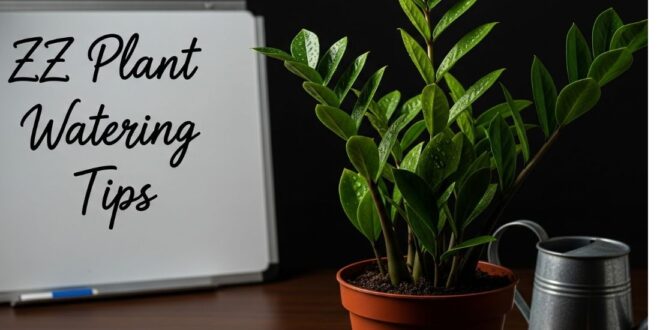Why Watering Matters Most for ZZ Plants
How often to water a ZZ plant is the most important question every ZZ plant owner should ask to ensure their plant stays healthy and thrives indoors. The Zamioculcas zamiifolia, or ZZ plant, has earned its reputation as one of the toughest, most resilient houseplants you can own. Its striking, glossy leaves and tolerance for low light make it a staple in modern homes and offices. It’s often called “un-killable.” Yet, there is one surprisingly common way this robust plant meets its demise: improper watering.
If you’re asking, “how often to water a ZZ plant?” you’re already on the right track. You understand that the answer isn’t as simple as the tag in the pot might suggest. The truth is, the single greatest threat to your ZZ plant’s health is too much affection in the form of overwatering.
This guide will provide the definitive answer. We will move beyond flawed schedules and empower you to understand exactly what your plant needs, ensuring it thrives for years to come.
Click on the title to read our more detailed guide about ZZ Plant. Your Ultimate ZZ Plant Guide: Care, Propagation, and Varieties
Why “How Often to Water a ZZ Plant” Has No Simple Answer
Let’s first dismantle the most common piece of bad advice: watering on a fixed schedule. A “water every Saturday” or “water every 15 days” routine is a recipe for disaster. This is because your plant’s water needs are not static; they are dynamic, changing based on its environment.
The real question isn’t “how often,” but “when does my plant need water?” To answer that, you must first understand the key factors at play.
The 5 Key Factors That Determine Watering Frequency

1. Light
Light fuels photosynthesis, the process through which plants create energy and consume water.
- High Light: A ZZ plant in a bright, indirectly lit spot is more metabolically active. It will use water more quickly, and its soil will dry out faster. This is the most significant variable when determining how often to water your ZZ plant.
- Low Light: While ZZ plants are famous for tolerating low light, this also means they are in a state of near-hibernation. Their water consumption will be drastically lower. A ZZ plant in a dim corner might only need water once every month or two. Overwatering in low light is the #1 cause of root rot.
2. Temperature and Humidity
The ambient climate of your room plays a significant role.
- Warm, Dry Conditions (Summer/Heating On): Higher temperatures and lower humidity lead to faster evaporation from the soil and increased transpiration (water loss) from the leaves. The plant will need water more frequently.
- Cool, Humid Conditions (Winter): In cooler temperatures, plant growth slows, and evaporation is minimal. The soil will stay wet for much longer. This is the period when you must be most cautious.
3. Pot Type and Size
The home you choose for your plant’s roots matters immensely.
- Terracotta/Clay Pots: These materials are porous, allowing air and moisture to pass through. They “breathe,” causing the soil to dry out much faster. This makes them an excellent choice for ZZ plants.
- Plastic or Glazed Ceramic Pots: These are non-porous and hold moisture for a long time. If you use one, you must be extra vigilant about checking soil dryness.
- The Golden Rule: Regardless of material, your pot must have a drainage hole. A ZZ plant sitting in stagnant water is a death sentence.
4. Soil Composition
Zamioculcas zamiifolia have underground rhizomes—thick, potato-like structures that store water. They are designed for drought, not for swamps. Therefore, they detest dense, water-retentive soil.
- Ideal Soil: Your ZZ plant needs a fast-draining, airy mix. Standard potting soil is often too heavy. Use a cactus/succulent mix, or create your own by amending regular potting soil with a generous amount of perlite, pumice, or coarse sand to improve aeration and drainage.
5. Plant Size and Maturity
A large, established ZZ plant with many stalks and a robust root system will consume water more quickly than a small, young plant or a new propagation. Adjust your expectations based on the plant’s size.
The Golden Rule: How to Know Exactly When to Water Your ZZ Plant
So, with all these factors in mind, how do you know when it’s time? The principle is simple:
Water your ZZ plant thoroughly only when the soil is 100% dry from top to bottom.
“Dry-ish” is not enough. “Slightly damp” is not enough. It needs to be completely dry. Here are three foolproof methods to check:
- The Finger Test: The classic. Insert your index finger deep into the soil, all the way to the second knuckle. If you feel any moisture whatsoever, do not water. Wait. If it feels completely dry and dusty, it’s time.
- The Chopstick/Skewer Trick: A cleaner alternative. Take a plain wooden chopstick or a bamboo skewer and gently push it all the way to the bottom of the pot. Leave it for a few seconds and pull it out. If it comes out clean and dry, it’s time to water. If it has dark, damp soil clinging to it, wait.
- The Weight Test: With experience, this becomes the quickest method. Get a feel for how heavy the pot is right after a thorough watering. Then, pick it up every week or so. You will be surprised at how much lighter it becomes when the soil is completely dry.
The Correct Watering Technique: A Step-by-Step Method

When the time is right, how you water is as important as when.
- Drench Thoroughly: Take the plant to a sink or bathtub. Pour water slowly and evenly over the entire surface of the soil until it is saturated.
- See it Drain: Continue watering until you see a generous amount of water flowing freely from the pot’s drainage hole. This ensures that all the roots, even those at the bottom, have had access to moisture.
- Discard All Excess Water: This is the most critical step. Let the pot sit for 10-15 minutes to drain completely. Then, tip out any and all water that has collected in the saucer or cachepot. Never allow the pot to sit in a puddle of water.
- Return to its Spot: Place your happy, hydrated plant back in its location and forget about it until the soil is bone dry again.
Reading the Signs: Overwatering vs. Underwatering
Your plant will communicate with you. You just need to learn its language.
Signs of an Overwatered ZZ Plant (High Alert!)
This is the most common and dangerous issue. The rhizomes are rotting from being suffocated in water.
- Yellowing leaves, especially at the base.
- Mushy, soft, or collapsing stems near the soil line.
- A foul, swampy smell coming from the soil (root rot).
- Leaves falling off with the slightest touch.
Signs of an Underwatered ZZ Plant (Easy to Fix!)
This is far less dangerous and much easier to remedy.
- Wrinkled or shriveled stems as the plant draws on its water reserves.
- Slightly drooping or curling leaves.
- Brown, crispy leaf tips.
- Stalled or stunted growth.
If you see signs of underwatering, simply give the plant a thorough watering using the method above. It will usually perk up within a day or two.
Frequently Asked Questions (FAQ)

1. How can I save an overwatered ZZ plant?
Act quickly. Gently remove the plant from its pot. Brush off the wet soil and inspect the rhizomes and roots. Healthy roots are firm and white/light tan. Rotted roots will be brown/black, mushy, and may smell bad. Using a sterile tool, trim off all rotted parts. If a lot of rot is present, you may need to let the healthy rhizomes air-dry for a day. Repot the plant in a clean pot with fresh, completely dry, well-draining soil. Do not water it for at least a week or two, giving the cuts time to heal.
2. Is bottom watering good for ZZ plants?
Bottom watering can be effective, but it’s riskier for ZZ plants. The method involves placing the pot in a tray of water and letting it absorb moisture from the bottom up. The danger is that it’s hard to know when the water has reached the rhizomes, and it’s very easy to supersaturate the soil. For ZZ plants, the top-down drenching method described above is safer because it guarantees drainage and reduces the risk of the rhizomes sitting in water.
3. How often should I water my ZZ plant in winter vs. summer?
You need to adjust drastically. In spring and summer (the growing season), the plant is active and will use water more regularly. You might water every 2-4 weeks, depending on your conditions. In fall and winter, the plant goes dormant. You must reduce watering significantly, potentially to once every 4-8 weeks or even less. Always, always check the soil first before even thinking about watering.
4. Why is my ZZ plant not growing?
There are a few common reasons. First, it might be winter, and the plant is in its natural dormancy period. Second, it may not be receiving enough light to fuel new growth. While they can survive in low light, these plants truly thrive in bright, indirect light. Third, chronic overwatering or underwatering can stress the plant and halt its growth.
5. An exposed rhizome is showing above the soil. Is this a problem?
Not at all; this is completely acceptable. It’s usually a sign of a healthy, growing plant whose rhizome system is expanding. The exposed part of the rhizome will become tough and skin-like. There is no need to bury it, but if you dislike the look, you can add a very thin layer of fresh soil on top during your next repotting.
6. Should I fertilize my ZZ plant? When and how?
ZZ plants are very light feeders. They do not require much fertilizer. If you wish to fertilize, do so only during the active growing season (spring and summer). Apply it once every 1-2 months. Crucially, only apply fertilizer to soil that is already moist (e.g., a day after watering) to avoid burning the roots. Never fertilize in the fall or winter.
7. Should I mist my ZZ plant?
No. Misting is unnecessary for ZZ plants as they are not sensitive to humidity. Wet foliage can also encourage fungal issues. It’s best to skip it.
8. Can I use tap water for my ZZ plant?
Yes, in most cases, tap water is fine. If your water is heavily treated with chlorine, you can let it sit out in an open container overnight to allow some of the chemicals to dissipate before watering.
9. What should I do with yellowing leaves?
A yellow leaf will not turn green again. First, identify and fix the underlying cause (usually overwatering). Then, you can prune the yellow leaf and its stem off at the base with a clean tool to improve the plant’s appearance and direct energy to new growth.
10. How long can a ZZ plant actually survive without water?
A very long time. Depending on the conditions, a mature ZZ plant in a low-light, cool spot can easily go 1-2 months or more without water due to its efficient rhizome storage system. This is why the golden rule is: When in doubt, don’t water.
Conclusion: Your Path to Becoming a ZZ Plant Expert
Mastering how often to water a ZZ plant is not about adhering to a schedule. It’s about becoming an observant plant owner. It’s about shifting your mindset from “I need to water my plant” to “I need to check if my plant needs water.”
Trust in the resilience of your Zamioculcas zamiifolia. It is a plant built to withstand neglect far better than it can withstand excessive care. By checking the soil, providing excellent drainage, and paying attention to the signs, you will not only keep your plant alive—you will help it truly flourish.
If you would like to read our ZZ Plant detailed maintenance guide, click on the title. Easy ZZ Plant Care for a Healthy Houseplant





